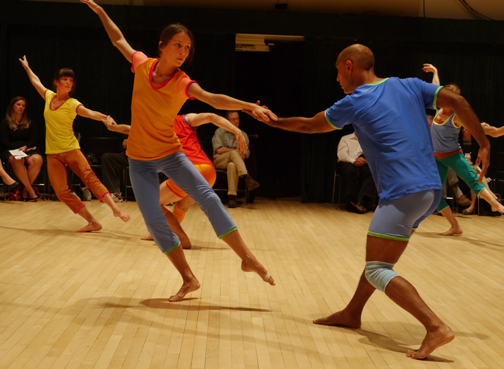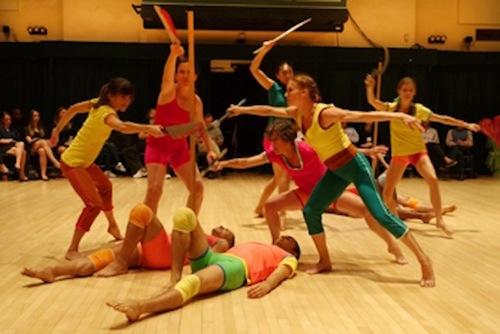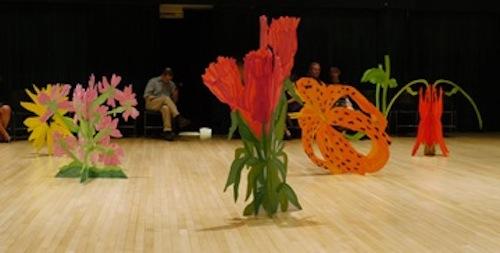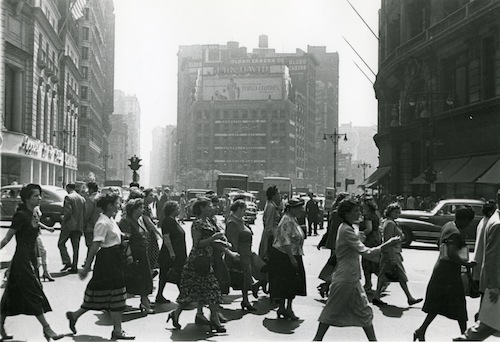
Douglas Dunn’s Cassations at Danspace, St. Marks-in-the-Bouwerie Church, February 7, 2013.
As I watched the performance I didn’t stop to consider what Douglas Dunn might mean by “cassations.” Cassation, “a minor form consisting of a suite of 18th century short musical works, usually played outside”—or in legal terms a negation or quash or annulment. (“Those are the breaks,” one surmises.) The first segment is danced to Mozart’s Cassation in G Major, K. 63, Andante. Later I read Douglas Dunn tell Nancy Dalva in The Brooklyn Rail how he liked the way “other words fly off it like rays from an exploding star.” In retrospect it’s the palpable form (a snap in the continuum), and its transposition indoors (I can picture it being danced in a meadow). The music, mostly for voice in concert setting, was around and about and sometimes worked like floorboards (easily gotten across, supportive) but also like weather with which the dancers sometimes had to contend. The dancing was to, with and on—musical throughout, even when “against” or poking fun at the toney demeanor of the accompaniment. But the godliness of the progression I thought was both conscious (there must have been some Ovid by Dunn’s bed) and instinctive, just as Pina Bausch’s mime parade of the seasons is felt as an artifice that goes a long way back. The clincher for me was the Arcadian sunshine finale, that vision of a beautiful life following soon (the wonderfully languorous “clouds” part intervening) after the war episode that in itself seemed awkward as war will, on stage. (Q: What form of combat is girls-versus-boys and rhymes with “cassation”?) Mimi Gross’s bright portable acrylic-on-Gatorboard flowerbeds were magnificent, and the men’s long poles and women’s swords, scythes, and axes looked make-do as weaponry should.


The St. Marks nave, the Poetry Project church we’ve spent so much life inside—listening and looking at thousands of poetry readings—became the set for this enchantment. Danspace has made its home there, founded by Larry Fagin some forty-plus years ago. Someone brightly said, “There are no better seats,” which readily seconded the sociability of Dunn’s company and the various dancers’ postures, but also how the audience—familiar faces and others you felt you should know—completed the view. I sat with Jenni Quilter and had John Godfrey for my lodestar, an old friend to bounce off of, on the far side. How you took it all in was up to you, so some interesting internal chatter became part of the show. Often the best was to face front, relax the eyes and let the wide gaze take its course, come what may. Auden called ballet a “present Eden.” Dunn’s work for keeps you there; days later you feel it radiating still.
[For a taste of Cassations in a version other than the one I saw, go to here.]
Rudy Burckhardt Films (Microcinema International, 2012)
Shots of earlier Douglas Dunn choreography make up about a third of Rudy Burckhardt’s Dancers, Buildings and People in the Street (1986), which, along with Millions in Business as Usual (1961), is one of very few essentials missing from the stupendous 3-disk set of Burckhardt’s cinematic pleasures as selected and transferred by his son Jacob. Having these twenty-three films available to everybody for home and classroom viewing is as great a cause for celebration imaginable for those who love the work already and even more so for the unsuspecting who don’t. To me by now many of his films are old friends. As Gertrude Stein said of herself, Burckhardt is popular because he has a small audience. Everyone should get to see all of him—and not just once, but repeatedly—the films and the photographs, his painting—and his autobiographical writings likewise bear rereading.

It’s great to have someone show you a thing you have passed thousands of times as something you never saw, and after seeing it you continue to pass it again and again and not see it.
—Alex Katz, on Rudy Burckhardt
Rudy shot what he liked, and by the wonder of sympathetic transmission you welcome his views in your own terms. What Edwin Denby called “the live light in them” spreads vividly. In the 1930s Rudy came to New York from Basel, Switzerland, and never looked back. No other photographer shows the light and air of New York so precisely, and no one gets the commonplace forms of motion and character, the casual dances New Yorkers make, walking and pausing at any intersection, so you yourself feel jolted. It’s not, as the lady said, all peaches and gravy. Burckhardt once described his philosophy as “Distinctly pessimistic, existential, negative thinking….” How much more amazing what he made of it.
Born in New York in 1939, Bill Berkson was a poet, critic, teacher and sometime curator, who became ...
Read Full Biography

